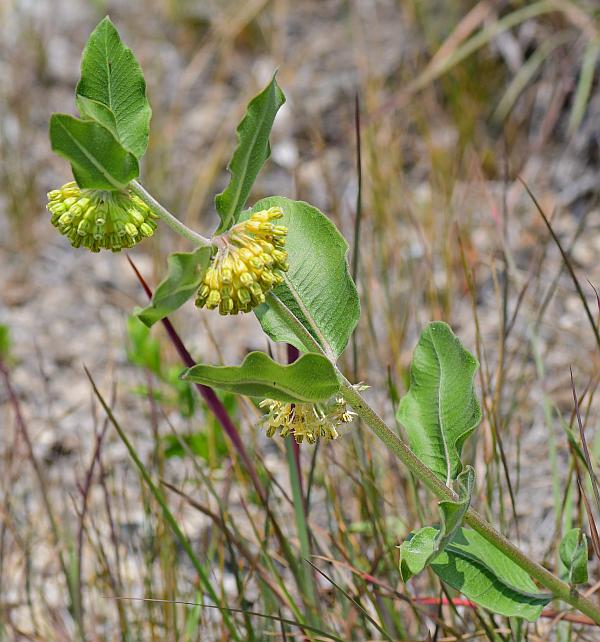Asclepias viridiflora Raf.
Green Milkweed

Native
CC = 7
CW = 5
MOC = 60
© SRTurner
Asclepias viridiflora Raf.Green Milkweed | |
 |
Native CC = 7 CW = 5 MOC = 60 |
© SRTurner |
|
Family - Asclepiadaceae Habit - Perennial forb with a thickened, somewhat woody rootstock. Stems - Spreading to weakly erect, to 90 cm, sometimes few-branched toward the tip, moderately short-hairy, sometimes in longitudinal lines or stripes, with milky sap, with 8 to numerous nodes.
Leaves - Opposite, simple, entire, decussate, short-petiolate, highly variable in shape. Petioles 2-3 mm long, often with a reddish tinge. Blades 2-12 cm long, 0.3-6.0 cm wide, linear to nearly circular in outline, the base rounded, narrowed, or tapered, the tip rounded or pointed, the margins flat and minutely hairy, glabrous or sparsely to moderately pubescent with minute hairs, especially on the undersurface and especially along the midvein. Venation anastomosing. Midrib distinctly whitish below.
Inflorescence - Axillary umbels, 1-6 per stem, sessile or short-pedunculate, with 20-80 flowers. Peduncles hairy, 2-3 mm long. Pedicels hairy, to 1 cm long.
Flowers - Calyx lobes 5, reflexed, minutely hairy, especially along the margins, 2.0-3.5 mm long, lanceolate. Corolla lobes 5, reflexed, glabrous or sparsely hairy, pale green, 5-7 mm long, elliptic-lanceolate. Gynostegium appearing sessile (the corona base touching the corolla or nearly so), pale green, the corona shorter than to nearly as long as the tip of the anther/stigma head. Corona hoods 4-5 mm long, reduced, not exceeding the anther column, glabrous, light green, erect, attached toward their bases, narrowly oblong-elliptic in outline, the tips rounded to bluntly pointed, the margins with a pair of short, triangular teeth or lobes below the middle, the bases pouched. Horns absent. Anther column green, white at the apex, 3.5-4 mm long. Pollinia 3 mm long, long-beaked, translator deep purplish-brown. Pistils 2, 3mm long, greenish-white, glabrous.
Fruits - Follicles 7-15 cm long, erect or ascending from usually deflexed stalks, narrowly elliptic-lanceolate in outline, the surface smooth, glabrous or more commonly minutely hairy. Seeds with the body 5.5-7.0 mm long, the margins narrowly winged, the terminal tuft of hairs cream-colored or tan.
Flowering - May - August. Habitat - Upland prairies, glades, bluff tops, sand prairies. Origin - Native to the U.S. Lookalikes - Broadly, some other milkweeds, e.g. A. meadii, A. hirtella. Other info. - This species is relatively common in its preferred habitat, though it is sometimes overlooked because of its nonshowy greenish flowers. It occurs throughout most of Missouri, possibly excepting some northern counties, and across most of the continental U.S. with the exception of a few western states. It is an easily recognized species with unique inflorescences. The flowers are unusual, lacking the "horn" structures common to other members of the genus. Despite the wide variation in leaf shape, ranging from very narrow to almost circular, discrete infraspecific forms cannot generally be defined because the variation is continuous. The flowers attract many insects desipte their lack of showiness, as can be seen in some of the photos above. Pollination in the milkweeds is highly specialized and unusual. For more information, see the Asclepias syriaca page of this website. Photographs taken at the Current River Conservation Area, Reynolds County, MO., 7-15-01 (DETenaglia), at Onondaga Cave State Park, Crawford County, MO, 6-24-2014 and Shaw Nature Reserve, Franklin County, MO, 6-17-2023 (SRTurner), and Victoria Glade, Jefferson County, MO, 6-25-2018 (KBildner). |